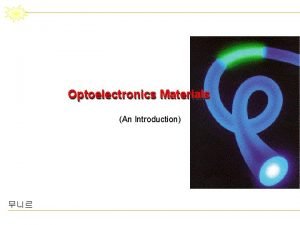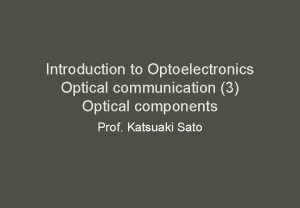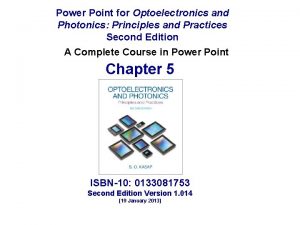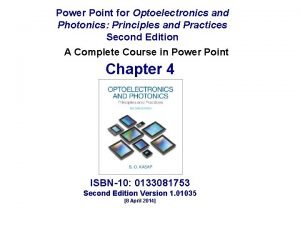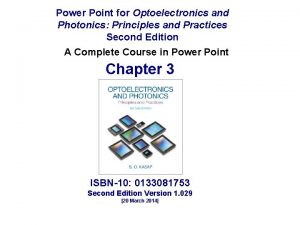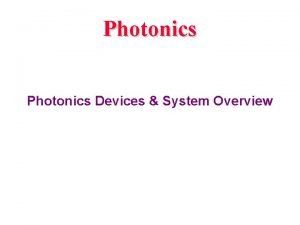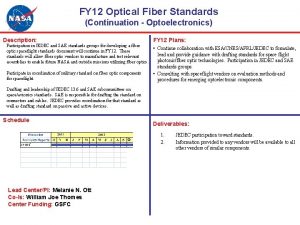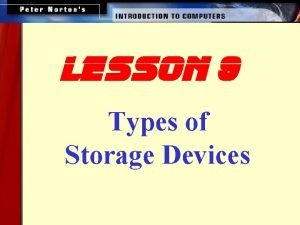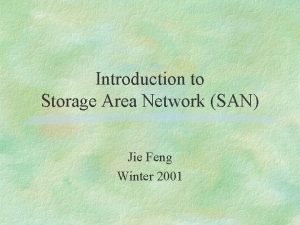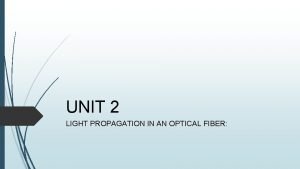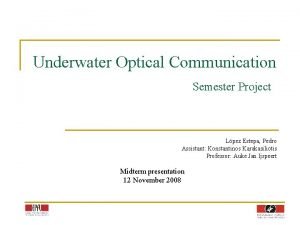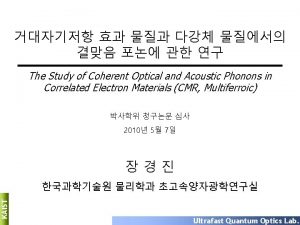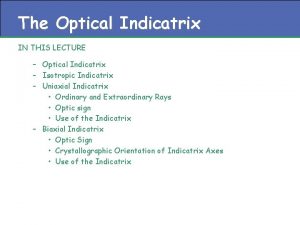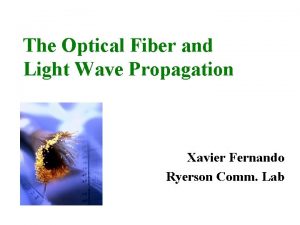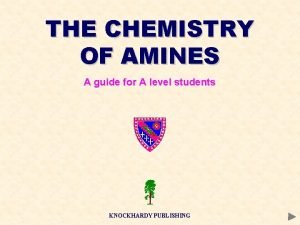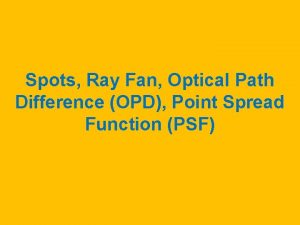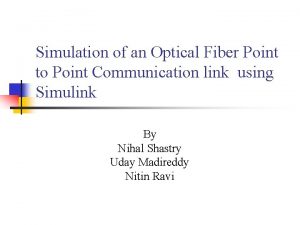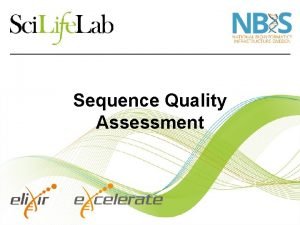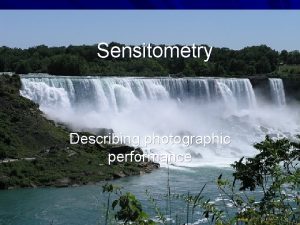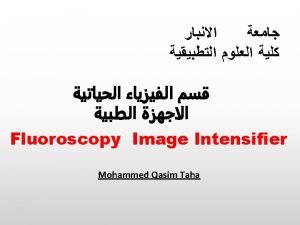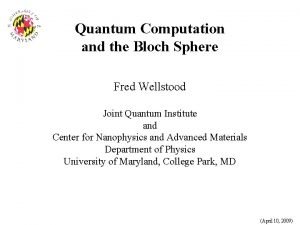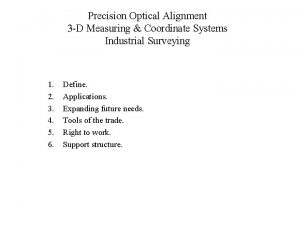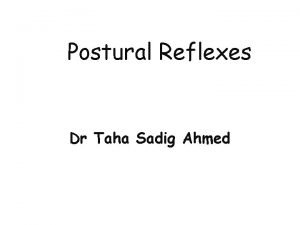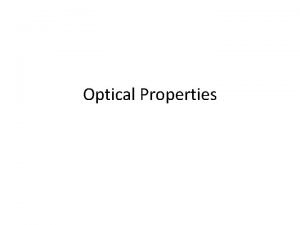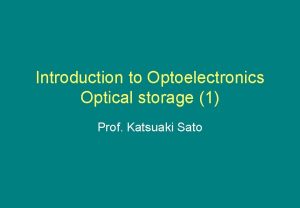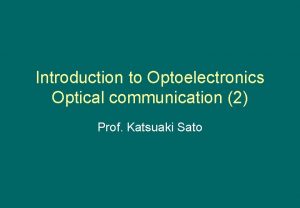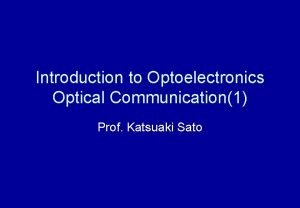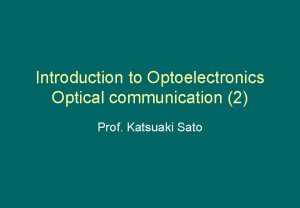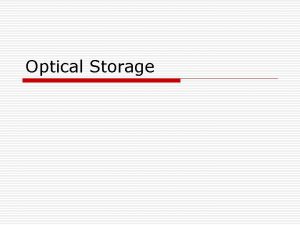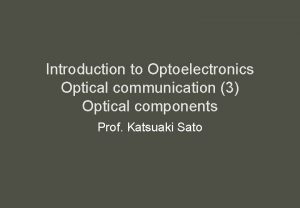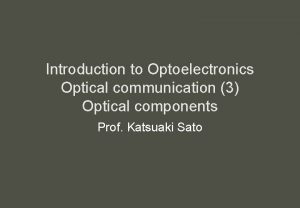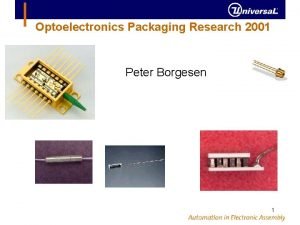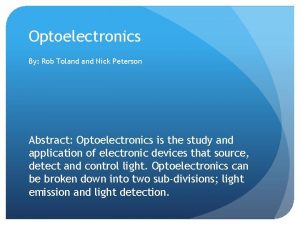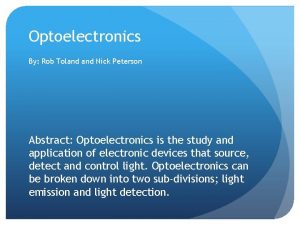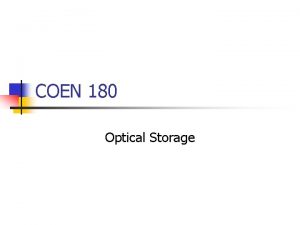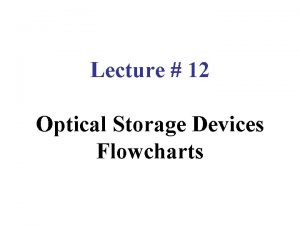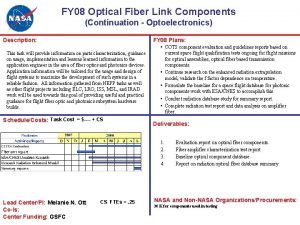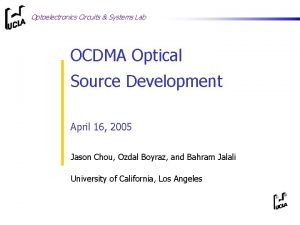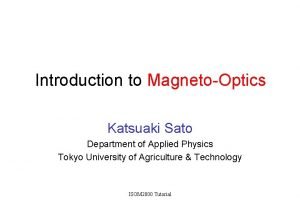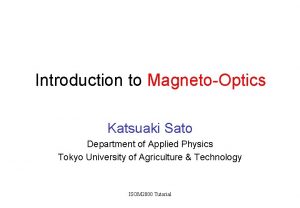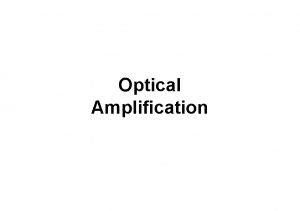Introduction to Optoelectronics Optical storage 2 Prof Katsuaki









































- Slides: 41

Introduction to Optoelectronics Optical storage (2) Prof. Katsuaki Sato

What we learn today. • Optical storage is a storage using light for read-out of recorded information • Record density is determined by the spot size of the light beam, which is limited by the wavelength of the light and the NA (numerical aperture) of lens. • There are three categories of optical storage, i. e. , read-only type, write-once type and rewritable type. • Different physical phenomena are used for recording of the signal on optical disks.

Spot size at the focal point • Numerical aperture of lens – NA=nsinα • d=0. 6λ/NA CD-ROM: NA=0. 6 λ=780 nm→d=780 nm DVD: λ=650 nm→d=650 nm BD: NA=0. 85 λ=405 nm→d=285 nm HD-DVD: NA=0. 6 λ=405 nm→d=405 nm α spot size d

Classification of optical storages • Optical disk – Read only type • CD, CD-ROM, DVD-ROM – Recordable type • Direct read after write (Write once type) – CD-R, DVD-R • Rewritable (recording and erasing) – Phase change CD-RW, DVD-RAM, DVD-RW, DVD+RW, BD, HD -DVD – Magneto-optical: MO, GIGAMO, MD, Hi-MD, AS-MO, i. D-Photo • Holographic memory, Hole-burning memory

Physical phenomena used in optical disk technology • CD-ROM, DVD-ROM: – pit formation • CD-R, DVD-R: – Chemical decomposition of organic dye • CD-RW, DVD-RAM, DVD-RW, DVD+RW : – Phase change between ordered and disordered states • MO, MD, GIGAMO, i. D-Photo, HD-MD: – Magnetic phase change between ferromagnetic and paramagnetic states • Holographic memory: Photorefractive effect • Hole-burning memory: Local structure change

Characteristics of optical disk • Removable • Large capacity, high density – 10 Gb/in 2 (far less than HD(100 Gb/in 2)) – Aiming at 100 Gb/in 2 using near-field technique • Random accessibility – Cassette MD, VTR DVD – Shorter access than magnetic tape – Longer seek time than HD • High reliability – Higher head clearance than HD

Increase of Areal Density in Optical Disks Optical disk MO Hard disk T. Suzuki: 113 th Topical Meeting of Magn. Soc. Jpn. (2000. 1) p. 11

Different Disks

CD-ROM • Polycarbonate substrates:n=1. 55 • λ=780 nm →λ’=503 nm (wavelength in the substrate) • Pit depth: 110 nm ~ ¼wavelength • Phase difference in reflectionπ: Destructive addition of reflected beams http: //www. infonet. co. jp/ueyama/ip/multimedia/cd. html

CD-ROM Drive • Focusing servo • Tracking servo • Optical pickup Objective lens Tracking Servo Quarter wave-plate Collimating lens Focusing Servo Grating Polarization Beam Splitter Cylindrical lens Optical detector http: //www. infonet. co. jp/ueyama/ip/multimedia/cd. html

CD-RW UV coat • Phase change • Crystalline and amorphous Protective layers Substrate Printed surface Reflection layer Recording layer Land http: //www. cds 21 solutions. org/main/osj/j/cdrw/rw_phase. html

Phase change recording • Phase change between different phases • Rewritable: As grown amorphous state is initialized to crystalline state by annealing. Recording is performed by heating above the melting point Tm (600 C) followed by quenching to amorphous state. Erasing is done by heating to Tcr(400 C) to crystallize. – High level :Heating above Tm→rapid cool→amorphous – Low level:Heating above Tcr→slow cool→crystalline DVD-RAM: Ge. Sb. Te based alloy DVD±RW: Ag-In. Sb. Te based alloy

Recording and erasing • Rapid cooling: amorphous →low reflectivity • Slow cooling below Tm crystalline →high reflectivity temperature Rapid cool melting point crystallization point Energy amorphous time melting point Slow cool crystallization point time activation energy low reflectivity http: //www. cds 21 solutions. org/main/o sj/j/cdrw/rw_phase. html crystalline high reflectivity

Crystalline and amorphous Initial:crystalline R: high Record recorded: amorphous R: low Erase laser spot recorded mark

What is amorphous? • Amorphous – non crystalline (disordered) state – without LRO (long range order) but with SRO (short range order) – Atomic arrangement of liquid is frozen – Metastable state introduced by rapid cooling of liquid – Random metallic alloy, chalcogenide glass, tetrahedral system, oxide glass – DRPHS (dense random packing of hard spheres) can explain RDF (radial distribution function)

Radial distribution function (RDF) • G(r): Probability to find a neighboring atom at a distance of r. Calculated experiment http: //cmt. dur. ac. uk/sjc/thesis/node 79. html

CD-R Protective layer Reflecting layer Pit PC substrate CD • Organic dye is used • Thermal decomposition • Deformation of substrate by heat • Work as a pit Protective layer Reflecting layer Organic dye layer Pre-groove Recorded mark PC substrate protective layer Dye layer PC substrate CD-R deformation of substrate laser beam

DVD Family DVD-ROM DVD-RAM DVD-RW DVD+RW capacity (GB) 4. 7 / 9. 4 2層 8. 54 3. 95 / 7. 9 4. 7 / 9. 4 4. 7/9. 4 Form disk cartridge disk Mark formation/ Material/ reflectivity wavelength nm lens NA pit formation 1 L R=45 -85 2 L R=18 -30 650/635 thermal deform organic dye phase change Ge. Sb. Te alloy phase change Ag. In. Sb. Te alloy 650/635 650 638/650 0. 6 0. 65 shortest mark size 1層: 0. 4 2層: 0. 44 0. 41 -0. 43 0. 4 track width 0. 74 0. 8 Wobbled Land pre-bit 0. 74 Wobbled L/G 0. 74 Wobbled Land pre-bit 0. 74 HF Wobbled groove 105 103 -104 Cyclability - R=45 -85% - R=18 -30%

MO(magneto-optical)Recording • Recording: Thermomagnetic (Curie point) recording – Heat-assisted magnetic recording • Playback: Magneto-optical effect – Rotation of linear polarization is converted to the electrical signal • • • Employed in MO, MD disks Compatibility High repeatability: 10, 000 times Complicated optical head (Polarization detection) Novel inventions such as MSR, MAMMOS, DWDD are realized as commercial products

Magneto-optical (MO) Recording • Recording: Thermomagnetic recording – Magnetic recording using laser irradiation • Reading out: Magneto-optical effect – Magnetically induced polarization state • • MO disk, MD(Minidisk) High rewritability:more than 107 times Complex polarization optics New magnetic concepts: MSR, MAMMOS and DWDD

History of MO recording • • • • 1962 Conger, Tomlinson Proposal for MO memory 1967 Mee Fan Proposal of beam-addressable MO recording 1971 Argard (Honeywel) MO disk using Mn. Bi films 1972 Suits(IBM) MO disk using Eu. O films 1973 Chaudhari(IBM) Compensation point recording to a-Gd. Co film 1976 Sakurai(Osaka U) Curie point recording on a-Tb. Fe films 1980 Imamura(KDD) Code-file MO memory using a-Tb. Fe films 1981 Togami(NHK) TV picture recording using a-Gd. Co MO disk 1988 Commercial appearance of 5”MO disk (650 MB) 1889 Commercial appearance of 3. 5 ”MO disk(128 MB) 1991 Aratani(Sony) MSR 1992 Sony MD 1997 Sanyo ASMO(5” 6 GB:L/G, MFM/MSR) standard 1998 Fujitsu GIGAMO(3. 5” 1. 3 GB) 2000 Sanyo, Maxell i. D-Photo(5 cmφ730 MB) 2004 Sony Hi-MD

Structure of MO disk media • MO disk structure Al reflection layer Groove Land Resin Polycarbonate substrate Si. Nx layer for protection and MO-enhancement MO-recording layer (amorphous Tb. Fe. Co)

MO recording How to record(1) • Temperature increase by focused laser beam • Magnetization is reduced when T exceeds Tc • Record bits by external field when cooling M Tc Temp Tc Coil External field MO media Laser spot

MO recording How to record(2) • Use of compensation point Hc writing • Amorphous Tb. Fe. Co: Ferrimagnet with Tcomp M • HC takes maximum at Tcomp – Stability of small recorded marks Fe, Co Tb Tb Fe. Co Mtotal RT Tcomp Tc T

Amorphous Tb. Fe. Co Film TM R (Fe, Co) (Tb) TM (Fe, Co) R (Tb)

Two recording modes • Light intensity modulation (LIM): present MO – Laser light is modulated by electrical signal – Constant magnetic field – Elliptical marks • Magnetic field modulation (MFM):MD, ASMO – Field modulation by electrical signal – Constant laser intensity – Crescent-shaped marks Constant laser beam Modulated laser beam Constant field (a) LIM Modulated field (b) MFM Magnetic head

Shape of Recorded Marks (a) LIM (light intensity modulation) (b) MFM (magnetic field modulation)

MO recording How to read • Magneto-optical conversion of magnetic signal to electric signal D 1 LD + D 2 N S N S Differential detection Polarized Beam Splitter

Structure of MO Head Bias field coil Recorded marks Track pitch Focusing lens Rotation of polarization MO film Beam splitter Half lens wave-plate mirror PBS LD (polarizing beam splitter) Laser diode Photo-detector PD=photodiode

Advances in MO recording 1. Super resolution 1. MSR 2. MAMMOS/DWDD 2. Use of Blue Lasers 3. Near field 1. SIL 2. Super-RENS (Ag. Ox)

MSR (Magnetically induced super-resolution) • Resolution is determined by diffraction limit – d=0. 6λ/NA, where NA=n sin α – Marks smaller than wavelength cannot α be resolved d • Separation of recording and reading layers • Light intensity distribution is utilized – Magnetization is transferred only at the heated region

Illustration of 3 kinds of MSR

AS-MO standard

i. D-Photo specification

MAMMOS (magnetic amplification MO system)

Super-RENS super-resolution near-field system • Ag. Ox film:decomposition and precipitation of Ag – Scattering center→near field – Ag plasmon→enhancement – reversible • Applicable to both phasechange and MO recording 高温スポット 近接場散乱

To shorter wavelengths • DVD-ROM: Using 405 nm laser, successful play back of marks was attained with track pitch =0. 26 m、mark length =213 m (capacity 25 GB) using NA=0. 85 lens [i]。 [i] M. Katsumura, et al. : Digest ISOM 2000, Sept. 5 -9, 2000, Chitose, p. 18. • DVD-RW: Using 405 nm laser, read / write of recorded marks of track pitch=0. 34 m and mark length=0. 29 m in 35 m two-layered disk(capacity: 27 GB) was succeeded using NA=0. 65 lens, achieving 33 Mbps transfer rate [ii] 。 [ii] T. Akiyama, M. Uno, H. Kitaura, K. Narumi, K. Nishiuchi and N. Yamada: Digest ISOM 2000, Sept. 5 -9, 2000, Chitose, p. 116.

Read/Write using Blue-violet LD and SIL (solid immersion lens) SILhead 405 nm LD NA=1. 5 405 nm 80 nm mark 40 GB I. Ichimura et. al. (Sony), ISOM 2000 Fr. M 01

SIL (solid immersion lens)

Optical recording using SIL

Hybrid Recording 405 nm LD Recording head (SIL) Readout MR head Achieved 60 Gbit/in 2 Tb. Fe. Co disk H. Saga et al. Digest MORIS/APDSC 2000, Tu. E-05, p. 92.
 Introduction to optoelectronics
Introduction to optoelectronics Introduction to optoelectronics
Introduction to optoelectronics Optoelectronics and photonics chapter 3 solution
Optoelectronics and photonics chapter 3 solution Einstein coefficient in laser
Einstein coefficient in laser Energy bands
Energy bands Photonic devices
Photonic devices Optoelectronics
Optoelectronics 4 storage devices of computer
4 storage devices of computer Types of optical storage
Types of optical storage Primary storage vs secondary storage
Primary storage vs secondary storage Primary storage and secondary storage
Primary storage and secondary storage Uses rigid metallic platters
Uses rigid metallic platters Unified storage vs traditional storage
Unified storage vs traditional storage Texte argumentatif introduction
Texte argumentatif introduction San vs nas
San vs nas Introduction to storage area networks
Introduction to storage area networks Cloud storage models and communication apis in iot
Cloud storage models and communication apis in iot Introduction to san and nas storage
Introduction to san and nas storage Introduction to storage
Introduction to storage Optical illusions science fair projects
Optical illusions science fair projects When light travels from an optically denser medium
When light travels from an optically denser medium V number in optical fiber
V number in optical fiber Underwater optical control
Underwater optical control Optical vs acoustic phonons
Optical vs acoustic phonons Polarization of light
Polarization of light Optical indicatrix
Optical indicatrix Skew rays in optical fiber
Skew rays in optical fiber Amino acid optical isomers
Amino acid optical isomers Precision optical lab
Precision optical lab Constitutional isomers
Constitutional isomers Ray fan plot
Ray fan plot Optical fiber simulation
Optical fiber simulation Alientrimmer
Alientrimmer Optical density of gross fog
Optical density of gross fog Northern optical ordinarily sells the x-lens for $50
Northern optical ordinarily sells the x-lens for $50 Real time fluoroscopy
Real time fluoroscopy Bloch sphere
Bloch sphere Precision optical alignment equipment
Precision optical alignment equipment Decorticate rigidity
Decorticate rigidity Optical industry
Optical industry Optical transport module
Optical transport module Optical property meaning
Optical property meaning
